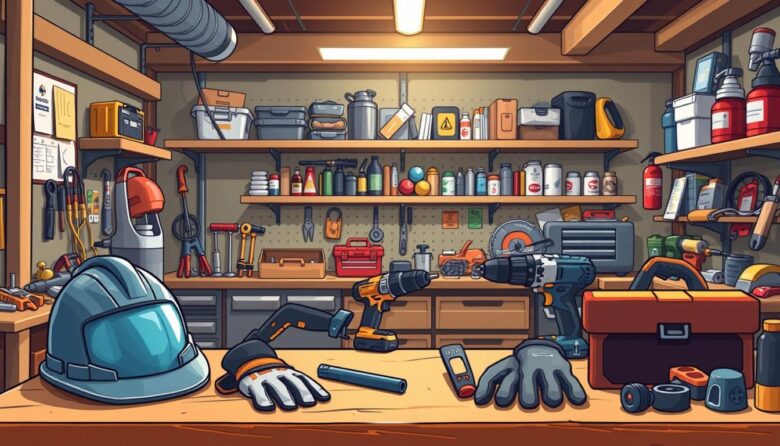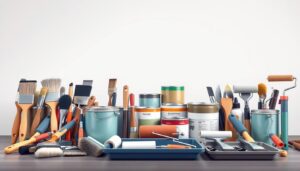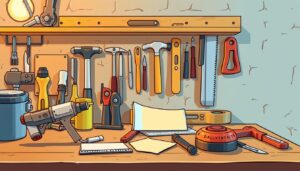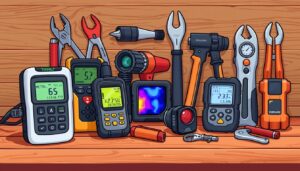Starting a home project is exciting. Many people enjoy the satisfaction of creating and fixing things themselves. However, every task, big or small, carries some level of risk. Proper preparation is the most important step you can take.
This guide will walk you through the essential items for your workspace. We focus on the right protection for different types of tasks. Our goal is to help you make smart choices for your well-being.
Having the correct gear does more than prevent accidents. It allows you to work with greater confidence and focus. You can concentrate on doing a great job instead of worrying about potential hazards.
We will cover everything from basic must-haves to specialized equipment. You will find specific product examples and practical advice. This information will prepare you for simple repairs or more complex DIY projects.
Investing in quality safety items is an investment in your health. It helps avoid immediate injuries and long-term issues. Let’s begin by building a foundation of knowledge for secure and successful DIY work.
The Importance of Safety Gear in DIY Projects
Many home improvement tasks involve hidden dangers that are not immediately obvious. Acknowledging these risks is the first step toward a secure and successful outcome for all your projects. The right gear is not an optional extra but a fundamental part of any DIY plan.
Understanding the Risks and Hazards in Home Improvement
Common workshop activities present several physical threats. Flying wood chips, dust, and chemical splashes can seriously injure your eyes. Loud tools like mowers and saws often exceed 85 decibels.
Prolonged exposure to this noise level causes permanent damage to the inner ear. Other hazards include sharp objects, heavy materials, and toxic fumes. Using the correct equipment is the most effective way to manage these dangers.
How Protective Equipment Enhances Efficiency and Peace of Mind
Wearing appropriate protection does more than prevent injuries. It allows you to work with greater confidence and focus. You can concentrate fully on the task instead of worrying about potential harm.
This mindset leads to better quality work and a more enjoyable experience. It is the best way to ensure your well-being while achieving your goals. Investing in quality safety items is an investment in your health and peace of mind.
Key DIY Safety Equipment for Every Project
The cornerstone of any secure workspace involves five fundamental types of protective gear that address different risks. These essential items work together to create comprehensive coverage for common home improvement activities.
Essential Protective Tools from Goggles to Gloves
Eye protection stands as the first line of defense. Safety goggles shield your vision from flying debris like wood shavings and metal particles. They also guard against chemical splashes from solvents and cleaners.
Hearing protection prevents permanent damage from loud power tools. Consistent use of earplugs or earmuffs maintains your auditory health during noisy tasks.
Hand protection comes through quality work gloves. These items safeguard against sharp objects, rough materials, and crushing injuries from heavy components.
Knee protection includes kneepads and portable mats. They provide comfort and prevent joint strain during extended kneeling work. This simple addition makes lengthy projects more manageable.
Body and foot protection completes your security setup. Steel-toe boots protect against falling objects, while coveralls shield your clothing from dust and chemicals. Having these core items readily available encourages consistent use for all your projects.
Eye and Ear Protection Fundamentals
Effective workshop safety begins with two critical areas: safeguarding your vision and preserving your hearing. These sensory protections work together to prevent both immediate injuries and long-term damage.
Selecting the Right Safety Goggles and Face Shields
Three levels of eye protection address different risk levels. Basic safety glasses with impact-resistant lenses and side shields protect against flying debris. Goggles create a seal around the eyes for comprehensive protection against particles and chemical splashes.
Face shields offer full-face coverage for high-speed operations. Proper goggles should be larger than reading glasses and wrap around the face. They must fit comfortably on the nose bridge when looking in all directions.
Look for anti-scratch and anti-fog coatings that maintain clear vision. Use goggles for tasks involving chemicals, grinding metal, or chiseling wood. Face shields are essential for power saws and welding operations.
Choosing Effective Earplugs and Earmuffs for Noise Control
Hearing protection devices carry a Noise Reduction Rating (NRR). Most standard earplugs and earmuffs block approximately 20 decibels of noise. Maximum hearing protection reaches about 50 decibels when combining foam canal plugs with earmuffs.
Disposable foam earplugs suit occasional use, while reusable silicone options work for regular projects. Choose earmuffs for extended periods or extremely loud equipment. Advanced Bluetooth options allow music listening while protecting your ears.
Wear proper hearing protection whenever operating loud tools or working in noisy environments. Consistent use prevents permanent damage to your ear over time.
Hands-On Gear: Gloves, Knee Pads, and Protective Clothing
Personal comfort and mobility define the effectiveness of hands-on protective gear. The right choices allow you to move freely while maintaining essential protection.
Finding the Perfect Fit for Work Gloves and Knee Pads
Selecting the right work gloves depends on personal preference and specific tasks. Tight-fitting styles improve your ability to handle small objects and maintain tactile sensitivity.
Proper fit ensures both comfort and functionality. Well-secured kneepads prevent slipping during movement. They provide consistent protection without restricting your range of motion.
Comparing Materials and Features for Long-Lasting Protection
Softer fabrics like cotton offer comfort but lack durability for rough work. Leather and rubber provide superior protection against sharp metal and harsh chemicals.
Advanced materials now offer strength exceeding traditional leather. These gloves maintain dexterity while providing enhanced durability.
For knee protection, kneepads suit mobile tasks requiring frequent repositioning. Stationary floor work benefits from foam mats that offer superior cushioning.
Protective clothing ranges from simple aprons to full-body coveralls. Each option addresses different project requirements and hazard levels.
Specialized Tools for Advanced DIY Tasks
Advanced home projects introduce unique hazards that demand specialized protection. When basic gear isn’t enough, you need equipment designed for specific risks.
Safeguarding Against Dust, Chemicals, and Debris
Respiratory protection becomes crucial for tasks generating significant airborne particles. Simple dust masks work for light sanding or sweeping, but advanced models offer superior filtration.
The RZ Mask features 99.9% efficient replaceable active carbon filters lasting 60+ hours. This affordable option (around $13.84) provides excellent protection during extended cutting or grinding work.
Upgrade to respirators when handling harmful chemicals or toxic fumes. Tasks like spray painting, welding metal, or working with epoxy require proper respiratory equipment.
Consider these respiratory options:
- Half-face respirators for chemical vapors and organic compounds
- Full-face models for complete facial protection
- Filters specifically designed for particulate hazards
Innovative technology like StopSaw systems (starting at $1499) represents the future of power tool safety. These advanced tools sense when something is in the way and prevent accidents instantly.
Additional specialized gear includes chemical-resistant gloves for harsh substances and flame-resistant clothing for metalwork. While representing a higher investment, this equipment is essential for regular advanced tasks.
Proper maintenance ensures your specialized protection remains effective. Replace respirator filters according to manufacturer guidelines and test safety features before each use.
A DIY Safety Equipment Buyer’s Guide
Smart shopping for protective gear balances cost, quality, and practical needs. Making informed choices ensures you get maximum value from every purchase.
Understanding Budget, Quality, and Versatility Considerations
Basic protective items are surprisingly affordable. Disposable coveralls cost just a few dollars, while basic kneepads run around $5.
Quality gloves often cost under $10, and protective goggles average $15. These items provide essential protection for occasional projects.
Mid-range gear ($40-$100) offers better durability for frequent use. Premium kneepads cost about $40, flame-resistant clothing around $64, and steel-toe boots $75-$110.
Consider these budget tiers:
- Basic tier: Under $20 for disposable or entry-level materials
- Mid-range: $40-$100 for enhanced comfort and longevity
- Premium: $80+ for specialized features like Bluetooth ear protection
Proper fit is crucial when selecting gear. Try on goggles, gloves, and kneepads before buying to ensure secure placement.
Prioritize versatile tools that work across multiple projects. Start with core items and expand your collection over time as needed.
Quality protection pays for itself by preventing injuries and lasting through many tasks. View these purchases as long-term investments in your well-being.
Wrapping Up: Steps to a Safe and Successful DIY Experience
Every successful home improvement journey begins with a commitment to personal protection. The five core categories—eye, ear, hand, knee, and body security—form your essential foundation.
Take time to assess your current inventory. Identify gaps based on the types of projects you regularly undertake. Proper protection prevents immediate injuries and safeguards against long-term health issues.
Investing in quality gear enhances work efficiency and builds confidence. Create a dedicated storage space to keep everything accessible and in good condition.
Lead by example when working with others. Demonstrate that proper safety practices are professional standards everyone should follow.
With the right knowledge and equipment, you can confidently tackle any DIY tasks. Focus on creative aspects rather than worrying about potential hazards.



